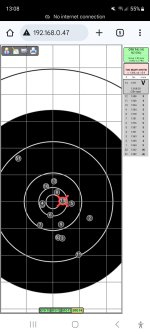Finally starting to get the rifle out more frequently now I'm doing less rimfire.
Took the rifle to an NRA shoot (FTR, F class, etc) shooting 3/5/600 yards, my dodgy 308 reloads and 16" barrel did well at 300 but fell apart after that, need to shoot some more to work out if it was just wind giving me vertical in my groups, or I need to speed more time tuning my load.
168gr ELD-Ms, Varget, Sellior Bellot (shite) brass, and ES of 50fps.
Quite a windy day with a variable 4-5oclock wind.
300yards, wind was difficult but group was .74moa tall including the first sighted I dialed down .1mil after.
500yards, not bad windage (was a windy day) but vertical is 1.4moa, would be a little less without first sighter
600yards, was really questioning my elevation after shots 6 and 7 so dialed up and ended up putting shot 9 quite high. Shot 6 was slow on the Garmin, not sure why 7 went low though.
600yards with some 168SMK Sellipr Bellot Match ammo, grouped well at 100yards but has an ES of 80, so wasn't expecting good things. A lot worse than 168 ELDMs in the wind.


